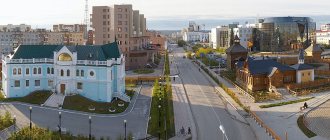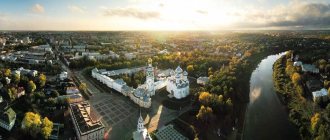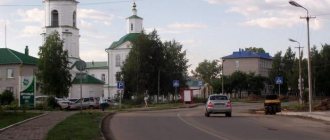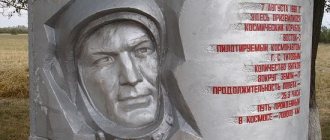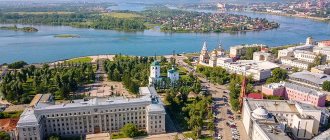Tulun is a city in the Irkutsk region, administrative ]Tulunsky district[/anchor].
Founded at the beginning of the 18th century.
City since 1927.
Area: 134 ± 1 km².
Population: 39,671 people (2020).
Nationalities: Russians (97%) and others.
Katoykonym: Tulunchane, Tulunchanin, Tulunchanka; Tuluntsy, Tulunets.
Time zone: UTC+8:00.
Telephone code: +7 39530.
Postal code: 665250.
OKATO code: 25 432.
OKTMO code: 25732000001.
Mayor: Yuri Vladimirovich Karikh.
Toponymy
Tulun is a word of Turkic origin. According to one of the existing versions, Tulun is translated as “leather bag”. The city received this name because of its location at the bend of the river, which goes around it and seems to take it in a bag.
This version is consonant with the information in the “Dictionary of Turkisms in the Russian Language,” published in 1976 under the editorship of Academician A.N. Kononova:
Tulun, metropolitan area, region (Sib.) skin removed with a pipe, entirely, without tearing lengthwise, tulunite, remove the skin with a tulun || leather fur, dressed and smoked for water (Orenb.), tzfsuk (Kavk.), wineskin (imoht.) (Dal, 4, 442). Experience, 1852 Tulun; from Mong. tulum (Sl. Acad., 1963, 15, 1116). “From Turkic, cf. tour. tulum 'skin' (Radlov, 3, 1470 et seq.)" (Vasmer, 4, 118). On tour. tulum 1. wineskin, 2. bagpipe (Magazanik, 1945, 629). Wed. tuluk and sheepskin coat.
Soviet specialist in the field of toponymy and cartography, Doctor of Geographical Sciences E.M. Pospelov in his monograph “Geographical Names of Russia” indicates that the word “tulun” comes from the Yakut “tolon” - valley.
Geography
Tulun is located on the Iya River (Angara basin), on the Irkutsk-Cheremkhovo Plain, in the forest-steppe zone of the foothills of the Eastern Sayan. The territory of the city is a hilly plain formed by the erosion activity of the Ii River and its tributaries. The relief of the territory is determined mainly by weak erosional dissection of calmly lying Jurassic and Ordovician sedimentary rocks.
- Topographic map of square N-47-B (Nizhneudinsk, Tulun, Kuitun)
Tulun is a word of Buryat origin and translated into Russian means “leather bag” or simply “bag”. This was the name of the area located in the loop-shaped bend of the Iya River.
The fact is that several centuries ago a group of nomadic Mongolian tribes moved to the Angara and Lena from Transbaikalia. These Mongol-speaking aliens became the ancestors of the Buryats. The Buryats lived in births at that time. The clan consisted of several uluses. On the site of modern Lenin Street, on the banks of the Iya River, stood the Buryat ulus of Tulun. According to Buryat legends, Tulun is a very old settlement. Around it there were many Buryat camps: Ikei, which translated from Buryat means “mother”, Edogon - “wizard”, Odon - “morning dawn”, Utai - “hillside”, etc. To this day the villages bear these names.
The date of origin of the settlement of Tulun has not been precisely established. According to Buryat legends, Tulun is a very old settlement, much older than Irkutsk or Nizhneudinsk. The study and development of the territory of the Irkutsk region by Russians began in the first half of the 17th century. Explorers played a big role in this. The first of them to appear within the region with his companions was P. D. Penda. He is in 1620-1623. from Yeniseisk I went down the Yenisei to the Lower Tunguska to explore a new route and visit the Yenisei River, and then to the Angara. Penda marked the beginning of the Russian discovery of Eastern Siberia, especially the Irkutsk region. He proved that the Upper Tunguska and the Angara are the same river. On the Angara, Penda saw several shelters and winter huts. To his surprise, Russian hunters lived in them, hunting fur-bearing animals, conducting barter trade with the Tungus. Penda's campaign is the most important historical stage in the development of our region. With the subsequent detachment of explorers, he discovered a lot of unknowns, showed an example of sober courage and prudence, and gave the key to resolving many issues that arose between explorers and local residents.
Following P.D. Penda, other explorers came to the territory of the region: Savin, Tyumenets, Perfilyev, Khriptsnov and others. In order to restore trust, good relations and mutual understanding with the local population, Ataman Maxim Perfilyev arrived to the “brotherly land” for the third time. All three campaigns allowed Perfilyev to achieve recognition of the Russians among the Buryat princes. His intelligence, humane and sincere attitude towards the Buryats and Evenks earned him good fame. Perfilyev fulfilled his ambassadorial mission: he managed to resolve the conflict peacefully. Good neighborly relations with the Buryats were restored. He decided to strengthen the Russian position on this land. For this purpose, in 1631, on the left bank of the Angara at the Padun rapids, Maxim Perfilyev erected a wooden fort, which was destined to be the beginning of the founding of Bratsk-Ostrozhny - the first Angara stronghold of the Russian advance further east, the Tulun land.
The Baikal region is a convenient region for exploration and settlement. The Angara crosses it in a northeast direction. Oka, Biryusa, Uda, Belaya, Kitoy seem to be roads convenient for moving deeper into the Baikal lands. Rising along the Oka and Iya rivers, Russian explorers founded settlements, which gradually grew into villages. This advance up the Iya River took 45 to 50 years. Thus, the Russians reached the Buryat tract Tulun in the 70s - 80s of the 17th century.
There was a second way for the Russians to appear in Tulun. Here is what I. I. Serebrennikov writes about this in his book “The Conquest of the Irkutsk Province”: In the area of the Iya River, where the Buryats lived - cattle breeders, the Russians came for the first time in 1652 under the “command of the Krasnoyarsk voivode Kirill Burlakov from the Nizhneudinsky fort. Here, on the territory of the Nizhneudinsky district, the Cossacks dominated. In 1645, the Krasnoyarsk governor Pyotr Protasyev sent a detachment of Cossacks against the Udin Buryats, but this campaign was not successful. The Buryats resisted. This forced Protasyev to turn to the Buryats for peace negotiations. They were asked to voluntarily recognize the power of the Russians over themselves. In 1647, the Udin Buryat prince Ilanko appeared in Krasnoyarsk, “made an oath of allegiance to the Russians here” and asked that a fort be established in his ulus both to protect him from the attack of the Mongols, and for a more convenient collection of yasak from the Buryats.
This request was accepted, and in 1648, on the eastern bank of the Uda River, the Udinsky fort was founded, which initially bore the name “Pokrovsky City”. In 1649, the Buryats were indignant and killed the Cossacks of the Pokrovsky town, sent to them for tribute collection. After this, they gathered in “great numbers” near the Iya River with the intention of “resisting the Russians by force.” And in 1652, the Krasnoyarsk governor Andrei Burlakov launched a campaign against the Buryats on the Iya River under the command of Kirill Burlakov. The campaign ended very successfully for the Russians; the Buryat resistance was finally broken. From that time on, the Buryats began to pay yasak to the Nizhneudinsky prison. From this time on, the first Russian settlements appeared. Russian new settlers began to build their homes next to the Buryats. Here they found convenient black soils that required relatively little effort to uproot. They began to clear, develop land, and build settlements: Kazakovo, Perfilovo, Afanasyevo, Nikitaevo and others. Zaimki were named after the first Russian explorers.
A Russian person is a farmer, a grain grower. He looked everywhere for suitable land on which he could create arable land, for which he used elani, clearings along the banks of rivers. They cleared land for arable land and crops, built houses, outbuildings, roads, bridges, bathhouses, and mills. In a word, they settled into the unknown wild taiga. Russian people were attracted here not only by the rich black earth lands, the forests were full of wild animals: moose, wild boars, fur-bearing animals of all kinds, rivers full of fish and other riches of birch and pine forests. The possibility of trade with the local population was important. All this could be quickly mastered and lived in. But the main wealth that Russian people strove for was land. Agriculture immediately became the economic basis of the region. Having settled next to the Buryats, the Russians helped them master more progressive methods of agriculture, taught them how to build huts and use plows. The theme of the appearance of Russian explorers in the Tulun area was the subject of a painting by M. I. Ivanov, a teacher at the Tulun Pedagogical School, a talented amateur artist. He called his painting “The Arrival of the Russians in Tulun in the 17th Century”; it is kept in the Tulun Local History Museum. Land was usually located on farmsteads 5-20 km from the village. Peasants usually went to farms for the entire summer for agricultural work. By winter they returned to the village.
Later, crafts began to develop in Tulun, especially blacksmithing. The blacksmiths lined up in one row and formed a street, which later received the name Kuznechnaya. Thus, Tulun from a Buryat ulus gradually turned into a Russian village.
In 1733, V. Bering led the second Kamchatka expedition, which lasted 10 years throughout Siberia and the Far East.
One of the detachments of this expedition was called Academic or Land, which headed along the Moscow road towards Irkutsk. This expedition included prominent scientists from the St. Petersburg Academy of Sciences. Collecting precious material on the flora and fauna and ethnography of Siberia along the way, the detachment arrived in Tulun on March 3, 1735. I. Gmelin wrote about this in his observation diary: “On March 3, 1735, before lunch at eight o’clock, we arrived from Udinsk to the village of Tulun after driving through a sparse, mostly pine forest. This village lies on the Oya River. It has 10 houses and is managed from Ilimsk.” These are the first mentions of the city of Tulun.
Initially, due to the long distance, economic ties between the Baikal region and central Russia were weak. The main routes are rivers. But they are extremely inconvenient as means of communication: they freeze for six months, have riffles, shoals, and rapids. Sometimes there is bad weather, and robbers can attack. All this interfered and delayed the journey. Every trip to Siberia was a feat. These trips dragged on for years.
Only in 1771 - 1772 did the Moscow land route pass through Tulun. The construction of the tract was a very important factor. Now the journey from Moscow became closer - it took several months, and sometimes weeks. The settlement quickly began to be built up and grow.
The road was very busy. One after another, numerous carts with tea, furs, fish, leather, lard, oil and other products moved west. Mostly industrial goods were brought from the west: fabrics, luxury goods, weapons, white flour, and more. Gold and silver were delivered from Siberia under special protection. All year round, “free passengers” traveled along the highway from one postal station to another, settlers followed with their belongings, officials and government couriers rushed on transfers, exiles and convicts walked through the stages, rattling their shackles.
The population of Tulun grew due to Russian peasants and exiles. By the beginning of the 18th century, there were already more than 150 households. And by the time the railway was built in 1895-1896, in the Tulun section “there were 627 revision souls.” In the 18th century it became a large trading merchant village: many shops, shops, visiting yards, taverns. There were many outbuildings on the estate (barns, bathhouses, barnyards). They also built stone houses in the village, sometimes even three-story ones. The wife of the prominent Siberian scientist and ethnographer Vinogradov, A.I. Tatarinova, wrote: “The village is large, crowded. The population is diverse in national composition: Russians, Jews, gypsies, Poles, Ukrainians, peoples of the Caucasus and others. The village has beautiful surroundings. It is surrounded on all sides by various forests. The estates are surrounded by high wooden fences and elegant carved plank gates. The houses were decorated with carved cornices and paneled shutters, and many houses had iron roofs. Tulun cabinetmakers were famous throughout the county for their ability to beautifully decorate houses. The entire central street of Tulun - “Big Street” - looked very elegant, because the houses were decorated very beautifully: window frames, shutters, gates, gates and even fences were covered with wooden lace. The carvings covered the eaves of houses in 3-4 rows. And all this delicate work was covered with white paint.
Many shops, benches, strong outbuildings, richly carved wooden houses, courtyards skillfully built by craftsmen, taverns - this is what made up the appearance of the then Tulun.
In 1926, according to the All-Union Census, 5,932 people lived in Tulun: 2,954 men and 2,978 women. Tulun has gone through a long and difficult path of development from a Buryat ulus to a modern city. It became a real city only during the Soviet period: on September 5, 1927, by Decree of the All-Russian Central Executive Committee, the village of Tulun was transformed into a city.
The Resolution states: “The village of Tulun with a railway settlement of the same name, Tulun District, Siberian Territory, from October 1, 1927, shall be converted into an urban settlement.
The new urban settlement will be named the city of Tulun.” Sources: https://dimon.shpack.net/ Tulun Museum of Local Lore
Climate
The climate of the Tulun region is sharply continental with cold, long winters and short, relatively hot summers. In any season of the year, sudden changes in weather are possible, a transition from heat to cold, sharp fluctuations in air temperature from month to month, from day to day and within 24 hours.
The average annual air temperature is negative (-2.4°C). The period with negative average monthly air temperatures lasts from October to April. January is the coldest month (its average monthly air temperature is 22.5°C). The absolute minimum was also observed in January - 55°C. Such low air temperatures are due to the strong cooling of the surface layer of air under conditions of predominance of anticyclonic weather in winter.
Transport accessibility
Tulun is located on the Trans-Siberian Railway and is a major transport hub. Within the city there are ESR stations Tulun and Nyura, as well as two stopping points. Federal highways “Baikal Krasnoyarsk - Irkutsk” and “Vitim” Tulun - Bratsk - Ust-Kut and then to Yakutsk pass through Tulun. The city is a junction of local roads that provide connections with populated areas in the region. The distance to the nearest large city of Bratsk is 225 km by road, to the regional center of Irkutsk - 389 km by rail and 428 km by road.
Criminal situation in the city. The city falls asleep, the mafia wakes up
It's no secret that everywhere there are their own influential groups. This system did not bypass the glorious city of Tulun. This can also be called its disadvantage. The districts are divided among influential people who run the local businesses. There are times when their importance goes beyond boundaries, and on the way to their goal or whim they spare no one.
Since the 90s, there have been terrible stories about the murders of Chinese businessmen, mass fights with visitors for spheres of influence, and arson of forest guards for the performance of their official duties. This is, of course, a thing of the past now. But in the evening it is better to behave carefully, especially if the person is alone. There have always existed, exist and will exist those people who are the bad link in society. You just need to stay away from them.
In general, the criminal situation in the city is at the level of all-Russian indicators. The city ranks lowest on the list when it comes to car thefts. The car can safely stand near the house, no one will touch it, this is a definite plus in comparison with the metropolis, where every night someone can encroach on their property.
Economy
Until the mid-1990s, Tulun was one of the industrialized cities in the region. Industrial production was the basis of the city's economy. The city's share in the total industrial output of the Irkutsk region exceeded 2%. Currently, due to the bankruptcy and liquidation of a number of enterprises, its production potential has declined catastrophically, and its share in the overall regional output of industrial products has fallen to 0.2% (based on the results of 2008 and 2009)7.
The largest enterprises in the city are the East Siberian Biotechnology Plant, created on the basis of a hydrolysis plant, and coal mines.
As of the first half of 2022, the following enterprises operated in Tulun:
• three enterprises providing electricity, gas and steam (Western Branch LLC, IP Styazhkin, IP Tryapitsyn);
• enterprise for the production of drinking mineral water (LLC “Beton”);
• enterprise for the production of other rubber products (IP Kiselyov);
• an enterprise for the production of other textile products (cotton work gloves, Rubin LLC);
• an enterprise for the production of plastic products used in construction (Kambiy LLC);
• four enterprises producing concrete products for use in construction (Concrete Corporation LLC, Energokompleks IKS LLC, Beton LLC, IP Silivanets);
• an enterprise for the production of seeds and seedlings of forest crops intended for forest restoration and the production of mulch from pine cones (Yenisei LLC).
• a plant for processing pine nuts, collecting and storing wild mushrooms, berries and herbs, producing and bottling drinking water, processing and packaging honey (Kedr LLC);
• enterprise for growing, collecting and processing herbs and wild plants (IP Poplevin);
• nine enterprises producing bread, bakery and confectionery products;
• a full-cycle enterprise from the development of design documentation for construction, reconstruction, major repairs of boiler houses, construction of modular boiler houses (Energokompleks LLC);
• production of wall house kits from rounded logs (construction of ecological and comfortable houses) Sibekodom LLC.
The trade and public catering network includes:
• 314 stores (66 food, 149 non-food, 99 department stores). Of the total number of department stores (with a mixed range of goods), food stores – 21%;
• 12 shopping complexes and centers;
• 60 non-stationary trade objects and 2 mobile trade objects;
• 58 public catering facilities (for 2,549 seats), of which 41 public catering facilities (cafes, bars, fast food) for 1,491 seats, 17 catering facilities in schools, colleges, and enterprises for 1,058 seats.
Large food retailers operate in the city - “KhlebSol”, “Economia”, “Svetofor”, “Khoroshiy”6.
Districts of Tulun
Local residents identify the following districts, subdistricts and microdistricts in the city: - Western part of the city, Station, divided into microdistricts SHT, Birch Grove, Station and Electrical Repair Plant; — The central part, which includes the microdistricts Avtovokzal, Zhukova, Manut, Stekolny and Center; — Hydrolyzny district, consisting of five-story and private residential buildings; — LDK area, where workers and personnel of the woodworking plant received housing. It is divided into the Zarechnaya, LDK and Shakhta microdistricts; — Coal Miners microdistrict, built around coal mines; — Nyura district and Sosnovy Bor microdistrict, consisting of private residential buildings; — Cottage village Pisarevo.
Population
Population dynamics of Tulun
| 1897 | 1926 | 1931 | 1939 | 1959 | 1967 | 1970 | 1973 | 1976 | 1979 |
| 2000 | 6000 | 7400 | 28 000 | 41 783 | 48 000 | 49 440 | 50 000 | 51 000 | 51 770 |
| 1982 | 1986 | 1987 | 1989 | 1992 | 1996 | 1998 | 2000 | 2001 | 2002 |
| 53 000 | 55 000 | 56 000 | 52 903 | 53 800 | 53 700 | 53 700 | 53 200 | 52 800 | 51 848 |
| 2003 | 2005 | 2006 | 2007 | 2008 | 2009 | 2010 | 2011 | 2012 | 2013 |
| 51 800 | 50 100 | 49 400 | 48 600 | 47 800 | 47 266 | 44 611 | 44 497 | 43 865 | 42 961 |
| 2014 | 2015 | 2016 | 2017 | 2018 | 2019 | 2020 | |||
| 42 336 | 42 029 | 41 987 | 41 671 | 41 640 | 41 279 | 39 671 |
Social sphere
Education
Municipal preschool education institutions as of 20206:
| № | Name | Telephone | Official site |
| 1 | Kindergarten "Alyonushka" | 40-420 4-91-15 | https://alenushka.tulunr.ru/ |
| 2 | Kindergarten "Antoshka" | 4-09-36 4-05-65 | https://antoshka.tulunr.ru |
| 3 | Kindergarten "Anyutka" | 4-09-48 | https://anutka.tulunr.ru |
| 4 | Child Development Center - Kindergarten "Harmony" | 2-96-49 | https://garmoniya.tulunr.ru |
| 5 | Child development center - kindergarten "Zhemchuzhinka" | 4-01-48 | https://jemchujinka.tulunr.ru |
| 6 | Kindergarten "Luchik" | 4-01-83 2-43-98 | https://luchik.tulunr.ru/ |
| 7 | Kindergarten "Malvina" | 2-10-33 | https://malvina.tulunr.ru/ |
| 8 | Kindergarten "Rainbow" | 2-03-61 | https://raduga.tulunr.ru |
| 9 | Combined kindergarten "Rodnichok" | 2-61-19 2-64-50 | https://tulunr.ru/rodnichok |
| 10 | Kindergarten "Firefly" | 2-97-65 | https://svetlyachok.tulunr.ru |
| 11 | Combined kindergarten "Teremok" | 2-51-66 | https://teremok.tulunr.ru |
| 12 | Kindergarten "Smile" | 4-02-84 | https://ulibka.tulunr.ru |
Municipal educational institutions as of 20206:
| № | Name | Telephone | Website |
| 1 | Secondary school No. 1 | 4-07-60 | https://pervograd.net/ |
| 2 | Secondary school No. 2 | 2-43-78 | https://sosh2.tulunr.ru/ |
| 3 | Secondary school No. 4 | 4-12-11 | https://sosh4.tulunr.ru/ |
| 4 | Secondary school No. 6 | 2-82-59 | https://sosh6.tulunr.ru |
| 5 | Secondary school No. 7 | 4-61-31 | https://sosh7.tulunr.ru/ |
| 6 | Secondary school No. 19 | 4-61-33 | https://sosh19.gtulun.ru |
| 7 | Secondary school No. 20 | 2-64-09 | https://sosh20.tulunr.ru |
| 8 | Secondary school No. 25 | 2-97-51 | https://sosh25.tulunr.ru |
| 9 | Gymnasium | 4-01-06 | https://gimn.tulunr.ru |
There is also a Center for Additional Education for Children and Youth “Crystal” (telephone: 4-11-07, website address: https://cristall.tulunr.ru).
Culture
- Siberia (leisure center)
- Prometheus (district palace of culture)
- “Leisya, song”, veterans’ choir
Content
- 1 Etymology
- 2 History
- 3 Geography 3.1 Transport
- 3.2 Climate
- 3.3 Relief
- 3.4 Geological structure
- 7.1 Schools
- 10.1 Local television
- 11.1 Mobile communications
Religion
The Church of the Intercession of the Mother of God in the city of Tulun was founded in 1740. In 1844, parishioners built a new church at their own expense, and the old one was renamed Assumption and remained until 1903, when, by order of the diocesan authorities, it was dismantled due to disrepair. In 1913, not far from the wooden one, a stone church of the same dedication was erected; the previous wooden one burned down in 1928. With the advent of Soviet power, the Church of the Intercession of the Mother of God was closed. From 1932 to 1944, the building housed workshops of a machine and tractor station, school workshops, a pioneer club, a branch of school No. 2, and a tannery. In December 1945, the building was returned to the believers, and on August 31, 1946, services resumed in the church. As of 2022, restoration work was underway in the Church of the Intercession of the Mother of God8. Address in Tulun: st. Sovetskaya, 19. Website: pokrovtulun.cerkov.ru/
Church of St. Nicholas the Wonderworker in the city of Tulun . Address in Tulun: st. Belova, 57. Website: nikola-tulun.cerkov.ru/
Authorities[ | ]
The structure of local government bodies of the city is [6]:
- Duma of the city district (City Duma) - the representative body of the municipal formation - “the city of Tulun”;
- Mayor of the urban district (mayor of the city) - head of the municipal entity - “Tulun city”;
- Administration of the urban district (city administration) - local administration of the municipality - “Tulun city”;
- The Chamber of Control and Accounts of the city district (the Chamber of Control and Accounts of the city) is the control and accounting body of the municipal formation - the “city of Tulun”.
Natives and residents
- Pavel Filippovich Nilin - Russian Soviet writer, playwright, screenwriter, winner of the Stalin Prize of the second degree (1941), lived and worked in Tulun in the 1920s. In 2008, on the initiative of the poet G. Gaida, a memorial plaque was installed in Tulun in honor of the writer Pavel Nilin.
- Angelina Mikhailovna Vovk is a popular Soviet TV presenter, born in Tulun.
- Evgeniy Danilyuk is an artist who lived in Tulun in 1970-80.
Notes
- Russian scientists have established the circumstances of the 2019 flood in Tulun // TASS. 2022. July 31
- Tulun. Flood anniversary // Regional newspaper. 2022. July 2.
- Tulun: life after the flood // Regional newspaper. 2022.10 July
- More than half of those affected by floods in the Angara region buy housing in their settlements // TASS. 2022. November 14
- The number of dead and missing in the Irkutsk region has been named // Lenta.Ru. 2022. July 2
- Administration of Tulun. Official site
- Tulun // Vinokurov M.A., Sukhodolov A.P. Cities of the Irkutsk region
- Church of the Intercession of the Mother of God in Tulun. Official site
Map of the city of Tulun. Tulun Yandex maps
Created using the Yandex service People's Map (Yandex map), when zoomed out you can understand the location of Tulun on the map of Russia. Tulun Yandex maps. Interactive Yandex map of the city of Tulun with street names, as well as house numbers. The map has all the symbols of Tulun, it is convenient and not difficult to use.
On the page you can read some descriptions of Tulun. You can also see the location of the city of Tulun on the Yandex map. Detailed with descriptions and labels of all city objects.
Share information with friends:


